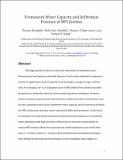| dc.contributor.author | Humplik, Thomas | |
| dc.contributor.author | Raj, Rishi | |
| dc.contributor.author | Maroo, Shalabh | |
| dc.contributor.author | Laoui, Tahar | |
| dc.contributor.author | Wang, Evelyn | |
| dc.date.accessioned | 2017-04-13T18:05:09Z | |
| dc.date.available | 2017-04-13T18:05:09Z | |
| dc.date.issued | 2014-01 | |
| dc.date.submitted | 2013-12 | |
| dc.identifier.issn | 1387-1811 | |
| dc.identifier.uri | http://hdl.handle.net/1721.1/108123 | |
| dc.description.abstract | The high specific surface area and sub-nanometer to nanometer pore dimensions of microporous materials (pores <2 nm) can be exploited to improve a variety of applications such as separation technologies, energy storage, and fuel cells. For example, the ≈5.5 Å diameter pore of MFI (Mobil Five) zeolites has been proposed as a molecular sieve for water-based separation techniques. However, results from past experimental and simulation studies have been inconsistent, even for basic quantities such as the framework water capacity and the pressure at which the MFI zeolite pores become water-saturated (infiltration pressure). In this work, we elucidate the underlying mechanisms behind such discrepancies via combined water adsorption and high-pressure infiltration (or intrusion) experiments on various MFI zeolites where the characteristic crystal dimension was varied from nano (≈10 nm) to micro (≈10 μm) scales. Detailed characterization techniques were utilized to demonstrate the presence of non-crystalline silica regions in <100 nm zeolites. Accordingly, an estimated decrease of up to 50% in the framework water capacity was observed for these zeolites when compared to the fully-crystallized larger zeolites, where 35 ± 2 water molecules were required to saturate a unit cell. On the other hand, the water infiltration pressure for all of the zeolites was ≈95–100 MPa despite the differences in the synthesis procedure, indicating uniformity in the crystallized pore structure and surface chemistry. These results are an essential first step towards investigating water transport mechanisms within the sub-nanometer pores and can be used to validate and improve upon existing molecular simulations in order to obtain design guidelines for practical applications such as water-based separation technologies. | en_US |
| dc.description.sponsorship | National Science Foundation (U.S.) (ECS-0335765) | en_US |
| dc.language.iso | en_US | |
| dc.publisher | Elsevier | en_US |
| dc.relation.isversionof | http://dx.doi.org/10.1016/j.micromeso.2014.01.026 | en_US |
| dc.rights | Creative Commons Attribution-NonCommercial-NoDerivs License | en_US |
| dc.rights.uri | http://creativecommons.org/licenses/by-nc-nd/4.0/ | en_US |
| dc.source | Prof. Evelyn Wang | en_US |
| dc.title | Framework water capacity and infiltration pressure of MFI zeolites | en_US |
| dc.type | Article | en_US |
| dc.identifier.citation | Humplik, Thomas; Raj, Rishi; Maroo, Shalabh C.; Laoui, Tahar and Wang, Evelyn N. “Framework Water Capacity and Infiltration Pressure of MFI Zeolites.” Microporous and Mesoporous Materials 190 (May 2014): 84–91. © 2014 Elsevier Inc | en_US |
| dc.contributor.department | Massachusetts Institute of Technology. Department of Mechanical Engineering | en_US |
| dc.contributor.approver | Wang, Evelyn N. | en_US |
| dc.contributor.mitauthor | Humplik, Thomas | |
| dc.contributor.mitauthor | Raj, Rishi | |
| dc.contributor.mitauthor | Maroo, Shalabh | |
| dc.contributor.mitauthor | Laoui, Tahar | |
| dc.contributor.mitauthor | Wang, Evelyn | |
| dc.relation.journal | Microporous and Mesoporous Materials | en_US |
| dc.eprint.version | Author's final manuscript | en_US |
| dc.type.uri | http://purl.org/eprint/type/JournalArticle | en_US |
| eprint.status | http://purl.org/eprint/status/PeerReviewed | en_US |
| dspace.orderedauthors | Humplik, Thomas; Raj, Rishi; Maroo, Shalabh C.; Laoui, Tahar; Wang, Evelyn N. | en_US |
| dspace.embargo.terms | N | en_US |
| dc.identifier.orcid | https://orcid.org/0000-0001-9482-2547 | |
| dc.identifier.orcid | https://orcid.org/0000-0001-7045-1200 | |
| mit.license | PUBLISHER_CC | en_US |
